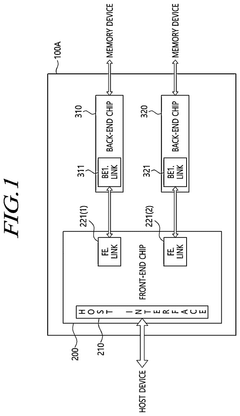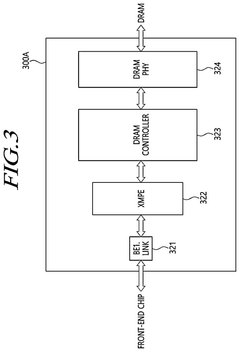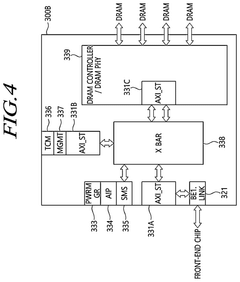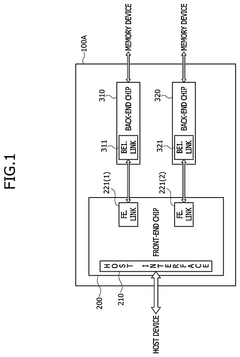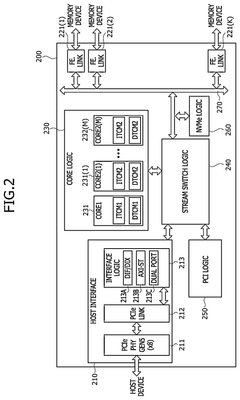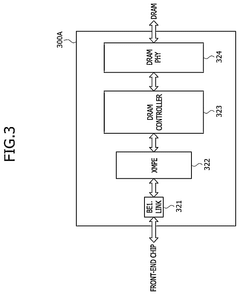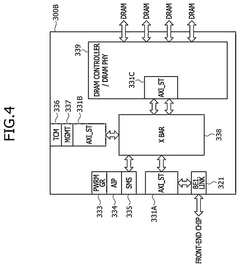How Chiplet Architecture Supports Scalable Data Storage?
JUL 16, 20259 MIN READ
Generate Your Research Report Instantly with AI Agent
Patsnap Eureka helps you evaluate technical feasibility & market potential.
Chiplet Architecture Evolution and Objectives
Chiplet architecture has emerged as a revolutionary approach in the semiconductor industry, offering a pathway to overcome the limitations of traditional monolithic chip designs. The evolution of chiplet architecture can be traced back to the early 2010s when the industry began to face challenges in scaling traditional integrated circuits. As Moore's Law reached its physical limits, chiplets presented a viable solution to continue improving performance and functionality.
The primary objective of chiplet architecture is to enable scalable and flexible chip designs by breaking down complex systems into smaller, more manageable components. This approach allows for the integration of diverse technologies and intellectual property (IP) blocks from different vendors, fostering innovation and reducing development costs. In the context of data storage, chiplet architecture aims to address the growing demands for higher capacity, improved performance, and enhanced energy efficiency.
The evolution of chiplet architecture in data storage systems has been driven by the exponential growth of data generation and the need for more sophisticated storage solutions. Initially, chiplets were primarily used to separate processing units from memory components, allowing for more efficient heat dissipation and improved performance. As the technology matured, chiplet designs began to incorporate specialized storage controllers, error correction modules, and interface components, further enhancing the capabilities of data storage systems.
One of the key objectives of chiplet architecture in data storage is to support scalability. By utilizing a modular approach, storage systems can be easily expanded or upgraded by adding or replacing individual chiplets, rather than redesigning entire monolithic chips. This flexibility allows for more cost-effective and rapid development of storage solutions that can adapt to changing market demands and technological advancements.
Another critical objective is to improve power efficiency and thermal management in data storage systems. Chiplet architecture enables the optimization of individual components for specific functions, leading to better overall system efficiency. For instance, storage controller chiplets can be designed with power-saving features, while high-performance memory chiplets can be optimized for speed and bandwidth.
Furthermore, chiplet architecture aims to enhance reliability and fault tolerance in data storage systems. By compartmentalizing different functions into separate chiplets, the impact of potential failures can be isolated and mitigated more effectively. This modular approach also facilitates easier maintenance and replacement of components, reducing downtime and improving overall system reliability.
As chiplet architecture continues to evolve, its objectives in supporting scalable data storage are expanding to include advanced features such as in-memory computing, near-data processing, and heterogeneous integration. These developments promise to revolutionize data storage systems by bringing computation closer to the data, reducing latency, and improving overall system performance.
The primary objective of chiplet architecture is to enable scalable and flexible chip designs by breaking down complex systems into smaller, more manageable components. This approach allows for the integration of diverse technologies and intellectual property (IP) blocks from different vendors, fostering innovation and reducing development costs. In the context of data storage, chiplet architecture aims to address the growing demands for higher capacity, improved performance, and enhanced energy efficiency.
The evolution of chiplet architecture in data storage systems has been driven by the exponential growth of data generation and the need for more sophisticated storage solutions. Initially, chiplets were primarily used to separate processing units from memory components, allowing for more efficient heat dissipation and improved performance. As the technology matured, chiplet designs began to incorporate specialized storage controllers, error correction modules, and interface components, further enhancing the capabilities of data storage systems.
One of the key objectives of chiplet architecture in data storage is to support scalability. By utilizing a modular approach, storage systems can be easily expanded or upgraded by adding or replacing individual chiplets, rather than redesigning entire monolithic chips. This flexibility allows for more cost-effective and rapid development of storage solutions that can adapt to changing market demands and technological advancements.
Another critical objective is to improve power efficiency and thermal management in data storage systems. Chiplet architecture enables the optimization of individual components for specific functions, leading to better overall system efficiency. For instance, storage controller chiplets can be designed with power-saving features, while high-performance memory chiplets can be optimized for speed and bandwidth.
Furthermore, chiplet architecture aims to enhance reliability and fault tolerance in data storage systems. By compartmentalizing different functions into separate chiplets, the impact of potential failures can be isolated and mitigated more effectively. This modular approach also facilitates easier maintenance and replacement of components, reducing downtime and improving overall system reliability.
As chiplet architecture continues to evolve, its objectives in supporting scalable data storage are expanding to include advanced features such as in-memory computing, near-data processing, and heterogeneous integration. These developments promise to revolutionize data storage systems by bringing computation closer to the data, reducing latency, and improving overall system performance.
Data Storage Market Trends and Demands
The data storage market is experiencing significant growth and transformation driven by the exponential increase in data generation across various sectors. This surge is primarily fueled by the rapid adoption of cloud computing, big data analytics, artificial intelligence, and the Internet of Things (IoT). As organizations increasingly rely on data-driven decision-making, the demand for efficient, scalable, and cost-effective storage solutions continues to rise.
One of the key trends in the data storage market is the shift towards solid-state drives (SSDs) and away from traditional hard disk drives (HDDs). SSDs offer faster read and write speeds, lower power consumption, and improved reliability compared to HDDs. This transition is particularly evident in enterprise storage systems, where performance and reliability are critical factors.
The cloud storage segment is witnessing substantial growth as businesses migrate their data and applications to cloud platforms. This trend is driven by the need for flexibility, scalability, and cost optimization. Major cloud service providers are expanding their data center infrastructure to meet the growing demand for storage capacity and computing power.
Edge computing is emerging as a significant driver of data storage demand. As IoT devices proliferate and generate vast amounts of data at the network edge, there is an increasing need for local storage and processing capabilities. This trend is pushing the development of compact, high-capacity storage solutions that can operate in diverse environmental conditions.
The enterprise storage market is evolving towards software-defined storage (SDS) and hyper-converged infrastructure (HCI) solutions. These approaches offer greater flexibility, easier management, and improved resource utilization compared to traditional storage architectures. Organizations are seeking storage solutions that can seamlessly integrate with their existing IT infrastructure and support hybrid and multi-cloud environments.
Data protection and security concerns are driving demand for advanced storage solutions with built-in encryption, data deduplication, and disaster recovery capabilities. As data breaches and cyber threats become more sophisticated, organizations are prioritizing storage systems that can ensure data integrity and compliance with regulatory requirements.
The growing adoption of artificial intelligence and machine learning applications is creating demand for high-performance storage systems capable of handling large-scale data processing and analysis. This trend is driving innovation in storage architectures, including the development of specialized AI-optimized storage solutions.
As the data storage market continues to evolve, there is a growing focus on sustainability and energy efficiency. Organizations are seeking storage solutions that can minimize power consumption and reduce their environmental footprint, aligning with broader corporate sustainability goals.
One of the key trends in the data storage market is the shift towards solid-state drives (SSDs) and away from traditional hard disk drives (HDDs). SSDs offer faster read and write speeds, lower power consumption, and improved reliability compared to HDDs. This transition is particularly evident in enterprise storage systems, where performance and reliability are critical factors.
The cloud storage segment is witnessing substantial growth as businesses migrate their data and applications to cloud platforms. This trend is driven by the need for flexibility, scalability, and cost optimization. Major cloud service providers are expanding their data center infrastructure to meet the growing demand for storage capacity and computing power.
Edge computing is emerging as a significant driver of data storage demand. As IoT devices proliferate and generate vast amounts of data at the network edge, there is an increasing need for local storage and processing capabilities. This trend is pushing the development of compact, high-capacity storage solutions that can operate in diverse environmental conditions.
The enterprise storage market is evolving towards software-defined storage (SDS) and hyper-converged infrastructure (HCI) solutions. These approaches offer greater flexibility, easier management, and improved resource utilization compared to traditional storage architectures. Organizations are seeking storage solutions that can seamlessly integrate with their existing IT infrastructure and support hybrid and multi-cloud environments.
Data protection and security concerns are driving demand for advanced storage solutions with built-in encryption, data deduplication, and disaster recovery capabilities. As data breaches and cyber threats become more sophisticated, organizations are prioritizing storage systems that can ensure data integrity and compliance with regulatory requirements.
The growing adoption of artificial intelligence and machine learning applications is creating demand for high-performance storage systems capable of handling large-scale data processing and analysis. This trend is driving innovation in storage architectures, including the development of specialized AI-optimized storage solutions.
As the data storage market continues to evolve, there is a growing focus on sustainability and energy efficiency. Organizations are seeking storage solutions that can minimize power consumption and reduce their environmental footprint, aligning with broader corporate sustainability goals.
Chiplet Technology: Current State and Challenges
Chiplet technology has emerged as a promising solution to address the challenges of scalability and performance in modern data storage systems. The current state of chiplet technology is characterized by significant advancements in integration and interconnect technologies, enabling the creation of more powerful and efficient storage solutions.
One of the primary challenges in chiplet-based data storage is the development of high-bandwidth, low-latency interconnects between chiplets. Current solutions include advanced packaging technologies such as 2.5D and 3D integration, which allow for the close proximity of multiple chiplets on a single package. These interconnects must be capable of handling the massive data throughput required for modern storage applications while maintaining low power consumption.
Another significant challenge is the design and optimization of chiplet architectures specifically for data storage applications. This involves balancing factors such as processing power, memory capacity, and I/O capabilities to create scalable and efficient storage solutions. Current approaches include disaggregating storage components into separate chiplets, allowing for more flexible and customizable configurations.
The integration of heterogeneous chiplets presents both opportunities and challenges for data storage systems. While it enables the combination of specialized components optimized for specific storage tasks, it also introduces complexities in terms of system design, thermal management, and power distribution.
Standardization efforts in chiplet interfaces and protocols are ongoing, with initiatives such as the Universal Chiplet Interconnect Express (UCIe) gaining traction. These standards aim to facilitate interoperability between chiplets from different manufacturers, potentially accelerating innovation and reducing costs in the data storage industry.
Thermal management remains a critical challenge in chiplet-based storage systems, particularly as data centers demand ever-increasing storage densities. Current solutions include advanced cooling techniques such as liquid cooling and the strategic placement of chiplets to optimize heat dissipation.
The adoption of chiplet technology in data storage is also driving innovations in manufacturing processes and supply chain management. Chiplet-based designs allow for more flexible production strategies, potentially reducing costs and improving yields. However, they also introduce new challenges in terms of testing and quality assurance across multiple chiplets.
As the demand for data storage continues to grow exponentially, chiplet technology is poised to play a crucial role in enabling scalable and efficient storage solutions. Ongoing research and development efforts are focused on addressing the current challenges and pushing the boundaries of what is possible with chiplet-based storage architectures.
One of the primary challenges in chiplet-based data storage is the development of high-bandwidth, low-latency interconnects between chiplets. Current solutions include advanced packaging technologies such as 2.5D and 3D integration, which allow for the close proximity of multiple chiplets on a single package. These interconnects must be capable of handling the massive data throughput required for modern storage applications while maintaining low power consumption.
Another significant challenge is the design and optimization of chiplet architectures specifically for data storage applications. This involves balancing factors such as processing power, memory capacity, and I/O capabilities to create scalable and efficient storage solutions. Current approaches include disaggregating storage components into separate chiplets, allowing for more flexible and customizable configurations.
The integration of heterogeneous chiplets presents both opportunities and challenges for data storage systems. While it enables the combination of specialized components optimized for specific storage tasks, it also introduces complexities in terms of system design, thermal management, and power distribution.
Standardization efforts in chiplet interfaces and protocols are ongoing, with initiatives such as the Universal Chiplet Interconnect Express (UCIe) gaining traction. These standards aim to facilitate interoperability between chiplets from different manufacturers, potentially accelerating innovation and reducing costs in the data storage industry.
Thermal management remains a critical challenge in chiplet-based storage systems, particularly as data centers demand ever-increasing storage densities. Current solutions include advanced cooling techniques such as liquid cooling and the strategic placement of chiplets to optimize heat dissipation.
The adoption of chiplet technology in data storage is also driving innovations in manufacturing processes and supply chain management. Chiplet-based designs allow for more flexible production strategies, potentially reducing costs and improving yields. However, they also introduce new challenges in terms of testing and quality assurance across multiple chiplets.
As the demand for data storage continues to grow exponentially, chiplet technology is poised to play a crucial role in enabling scalable and efficient storage solutions. Ongoing research and development efforts are focused on addressing the current challenges and pushing the boundaries of what is possible with chiplet-based storage architectures.
Chiplet-based Data Storage Solutions
01 Modular chiplet design for scalability
Chiplet architecture allows for modular design, enabling scalability by combining different chiplets to create larger, more complex systems. This approach allows for flexibility in system configuration and performance scaling, as well as easier integration of heterogeneous components.- Modular chiplet design for scalability: Chiplet architecture allows for modular design, enabling scalability by combining different functional blocks or chiplets. This approach allows for flexible configuration and easier upgrades, as individual chiplets can be replaced or added without redesigning the entire system. The modular nature also supports mix-and-match of different process technologies for optimal performance and cost-effectiveness.
- Interconnect technologies for chiplet integration: Advanced interconnect technologies are crucial for chiplet architecture scalability. These include high-bandwidth, low-latency interfaces between chiplets, such as silicon interposers, advanced packaging techniques, and die-to-die communication protocols. Efficient interconnects enable seamless integration of multiple chiplets, allowing for increased system complexity and performance scaling.
- Power management and thermal considerations: Scalable chiplet architectures require sophisticated power management and thermal solutions. This includes techniques for dynamic power gating, voltage scaling, and thermal management across multiple chiplets. Efficient power distribution and heat dissipation are essential for maintaining performance and reliability as the number of chiplets increases.
- Memory hierarchy and cache coherence: Scalable chiplet designs often involve complex memory hierarchies and cache coherence protocols. This includes strategies for maintaining data consistency across multiple chiplets, efficient memory access mechanisms, and optimized cache architectures. These considerations are crucial for ensuring performance scalability as the number of processing elements increases.
- System-level integration and software support: Achieving scalability in chiplet architectures requires comprehensive system-level integration and software support. This includes developing APIs and middleware for efficient chiplet communication, resource management across multiple chiplets, and software frameworks that can effectively utilize heterogeneous chiplet configurations. Standardization efforts in chiplet interfaces and protocols also play a crucial role in enabling scalable and interoperable designs.
02 Interconnect technologies for chiplet integration
Advanced interconnect technologies are crucial for chiplet architecture scalability. These include high-bandwidth, low-latency interfaces that allow efficient communication between chiplets, enabling seamless integration and performance scaling across multiple chips.Expand Specific Solutions03 Power management and thermal considerations
Scalable chiplet architectures require sophisticated power management and thermal solutions. This includes techniques for dynamic power allocation, efficient heat dissipation, and thermal management across multiple chiplets to maintain performance and reliability as systems scale.Expand Specific Solutions04 Memory hierarchy and cache coherence
Scalable chiplet architectures necessitate efficient memory hierarchies and cache coherence protocols. This involves designing memory systems that can maintain performance and consistency across multiple chiplets, including distributed caches and memory controllers.Expand Specific Solutions05 Software and operating system support
Effective scaling of chiplet architectures requires software and operating system support. This includes developing APIs, drivers, and runtime systems that can efficiently manage and utilize the distributed resources of a chiplet-based system, enabling seamless scalability from the software perspective.Expand Specific Solutions
Key Players in Chiplet and Data Storage Industries
The chiplet architecture market for scalable data storage is in a growth phase, with increasing adoption across the industry. The market size is expanding rapidly as major players invest heavily in this technology. Chiplet architecture's technical maturity is advancing, with companies like Intel, AMD, and Samsung leading the way in development and implementation. Micron and SK hynix are also making significant strides in memory-specific chiplet solutions. The competitive landscape is intensifying as more firms, including Huawei and IBM, enter the space, driving innovation and diversification of chiplet-based storage solutions. This technology is poised to revolutionize data storage scalability and efficiency in the coming years.
Micron Technology, Inc.
Technical Solution: Micron's approach to chiplet architecture for scalable data storage focuses on their Hybrid Memory Cube (HMC) technology and advanced 3D NAND solutions. The HMC utilizes Through-Silicon Vias (TSVs) to stack multiple DRAM dies, creating a high-bandwidth, low-power memory solution ideal for data-intensive applications. This architecture provides up to 15 times the bandwidth of a DDR3 module while using 70% less energy per bit[5]. In the realm of NAND storage, Micron's 176-layer 3D NAND technology employs a CMOS-under-array design, which allows for smaller die sizes and improved energy efficiency. This architecture enables the creation of high-capacity, high-performance SSDs that can scale to meet growing data storage demands[6]. Micron is also exploring the integration of compute-in-memory capabilities within their DRAM products, potentially allowing for more efficient data processing in storage-intensive applications.
Strengths: High bandwidth, energy efficiency, and scalability in both DRAM and NAND technologies. Weaknesses: Complexity in manufacturing processes and potential cost implications for high-end solutions.
SK hynix, Inc.
Technical Solution: SK hynix's approach to chiplet architecture for scalable data storage is centered around their High Bandwidth Memory (HBM) products and advanced NAND technologies. The company's HBM2E solution, for instance, offers bandwidth of up to 460GB/s per stack, making it ideal for data-intensive applications such as AI and high-performance computing[7]. SK hynix has also developed a 238-layer 4D NAND flash memory, which utilizes a unique architecture that combines the cell array and peripheral circuits in a single chip, allowing for higher capacity and improved performance in a smaller form factor[8]. In terms of chiplet integration, SK hynix is exploring advanced packaging technologies, including fan-out wafer-level packaging (FOWLP) and silicon interposers, to enable the efficient combination of memory chiplets with logic dies, supporting scalable and high-performance data storage solutions.
Strengths: High-bandwidth memory solutions, advanced NAND technology, and exploration of innovative packaging techniques. Weaknesses: Potential challenges in cost-effective implementation of advanced packaging technologies at scale.
Core Innovations in Chiplet Architecture for Storage
Devices using chiplet based storage architectures
PatentPendingUS20240427522A1
Innovation
- A chiplet-based storage architecture that includes a front-end chip for high-speed communication with host devices and multiple back-end chips for low-speed communication with memory devices, allowing for independent updates and replacements of chips to adapt to changing standards without altering the entire system, utilizing a daisy chain scheme for efficient data transmission.
Data receiving circuit for chiplet based storage architectures
PatentPendingUS20240371422A1
Innovation
- A chiplet-based storage architecture with a front-end chip and multiple back-end chips, allowing for independent configuration and replacement of each chip, supports different communication protocols and standards through PCIe and CXL protocols, enabling adaptive data storage operations without needing to change the entire system.
Thermal Management in Chiplet-based Storage Systems
Thermal management is a critical aspect of chiplet-based storage systems, as the increased integration density and power consumption of these architectures can lead to significant heat generation. Effective thermal management is essential for maintaining optimal performance, reliability, and longevity of chiplet-based storage solutions.
One of the primary challenges in thermal management for chiplet-based storage systems is the uneven heat distribution across the package. Different chiplets may generate varying amounts of heat depending on their function and workload. This non-uniform heat distribution can lead to hotspots, which can negatively impact the overall system performance and reliability.
To address these challenges, several thermal management techniques have been developed specifically for chiplet-based architectures. Advanced packaging technologies, such as 2.5D and 3D integration, play a crucial role in heat dissipation. These technologies allow for the incorporation of through-silicon vias (TSVs) and interposers, which can facilitate more efficient heat transfer between chiplets and the package substrate.
Active cooling solutions, such as liquid cooling and microfluidic channels, are being explored to enhance thermal management in chiplet-based storage systems. These techniques offer higher cooling capacity compared to traditional air cooling methods and can be more effectively integrated into the compact chiplet architecture.
Thermal-aware design methodologies are increasingly important in chiplet-based storage systems. This approach involves considering thermal characteristics during the early stages of system design, including chiplet placement, interconnect routing, and power distribution. By optimizing the physical layout of chiplets and incorporating thermal considerations into the design process, engineers can minimize hotspots and improve overall thermal performance.
Dynamic thermal management techniques are also being implemented in chiplet-based storage systems. These include adaptive clock gating, dynamic voltage and frequency scaling (DVFS), and workload migration between chiplets. These techniques allow the system to dynamically adjust its performance and power consumption based on thermal conditions, ensuring optimal operation within safe temperature limits.
The development of advanced thermal interface materials (TIMs) is another area of focus for improving thermal management in chiplet-based storage systems. Novel TIMs with higher thermal conductivity and better mechanical properties are being researched to enhance heat transfer between chiplets, interposers, and heat sinks.
As chiplet-based storage systems continue to evolve, thermal management will remain a critical area of research and development. The integration of artificial intelligence and machine learning algorithms for predictive thermal management is an emerging trend that holds promise for further improving the efficiency and reliability of these systems.
One of the primary challenges in thermal management for chiplet-based storage systems is the uneven heat distribution across the package. Different chiplets may generate varying amounts of heat depending on their function and workload. This non-uniform heat distribution can lead to hotspots, which can negatively impact the overall system performance and reliability.
To address these challenges, several thermal management techniques have been developed specifically for chiplet-based architectures. Advanced packaging technologies, such as 2.5D and 3D integration, play a crucial role in heat dissipation. These technologies allow for the incorporation of through-silicon vias (TSVs) and interposers, which can facilitate more efficient heat transfer between chiplets and the package substrate.
Active cooling solutions, such as liquid cooling and microfluidic channels, are being explored to enhance thermal management in chiplet-based storage systems. These techniques offer higher cooling capacity compared to traditional air cooling methods and can be more effectively integrated into the compact chiplet architecture.
Thermal-aware design methodologies are increasingly important in chiplet-based storage systems. This approach involves considering thermal characteristics during the early stages of system design, including chiplet placement, interconnect routing, and power distribution. By optimizing the physical layout of chiplets and incorporating thermal considerations into the design process, engineers can minimize hotspots and improve overall thermal performance.
Dynamic thermal management techniques are also being implemented in chiplet-based storage systems. These include adaptive clock gating, dynamic voltage and frequency scaling (DVFS), and workload migration between chiplets. These techniques allow the system to dynamically adjust its performance and power consumption based on thermal conditions, ensuring optimal operation within safe temperature limits.
The development of advanced thermal interface materials (TIMs) is another area of focus for improving thermal management in chiplet-based storage systems. Novel TIMs with higher thermal conductivity and better mechanical properties are being researched to enhance heat transfer between chiplets, interposers, and heat sinks.
As chiplet-based storage systems continue to evolve, thermal management will remain a critical area of research and development. The integration of artificial intelligence and machine learning algorithms for predictive thermal management is an emerging trend that holds promise for further improving the efficiency and reliability of these systems.
Standardization Efforts in Chiplet Technology
Standardization efforts in chiplet technology are crucial for enabling interoperability and fostering widespread adoption in the data storage industry. Several industry consortia and organizations are actively working to establish common standards and protocols for chiplet-based architectures.
The Universal Chiplet Interconnect Express (UCIe) consortium, formed in 2022, is leading the charge in developing open standards for die-to-die interconnects. UCIe aims to create a unified ecosystem that allows chiplets from different vendors to work seamlessly together. This standardization effort is particularly significant for data storage applications, as it enables the integration of diverse storage technologies and processing elements on a single package.
Another important initiative is the Open Compute Project (OCP), which has been working on standardizing chiplet-based designs for data center applications. The OCP's efforts include defining common form factors, power delivery, and thermal management standards for chiplet-based storage solutions. These standards are essential for ensuring compatibility and scalability in large-scale data storage systems.
The CHIPS Alliance, an open-source hardware initiative, is also contributing to chiplet standardization by developing open-source tools and IP for chiplet-based designs. Their work includes creating reference designs and verification methodologies that can accelerate the adoption of chiplet architectures in data storage applications.
In the realm of memory interfaces, the JEDEC Solid State Technology Association is working on standards for High Bandwidth Memory (HBM) and other advanced memory technologies that are crucial for chiplet-based storage systems. These standards ensure that memory chiplets can efficiently communicate with processing elements and storage controllers.
The IEEE is also playing a role in chiplet standardization through its P3047 working group, which is focused on developing standards for heterogeneous integration and packaging of integrated circuits. This work is particularly relevant for data storage applications that require the integration of diverse technologies such as NAND flash, DRAM, and processing elements.
As these standardization efforts progress, they are paving the way for more modular and scalable data storage solutions. By enabling mix-and-match capabilities between chiplets from different vendors, these standards are fostering innovation and competition in the data storage market. This, in turn, is leading to more efficient, higher-capacity, and cost-effective storage solutions that can meet the ever-growing demands of data-intensive applications.
The Universal Chiplet Interconnect Express (UCIe) consortium, formed in 2022, is leading the charge in developing open standards for die-to-die interconnects. UCIe aims to create a unified ecosystem that allows chiplets from different vendors to work seamlessly together. This standardization effort is particularly significant for data storage applications, as it enables the integration of diverse storage technologies and processing elements on a single package.
Another important initiative is the Open Compute Project (OCP), which has been working on standardizing chiplet-based designs for data center applications. The OCP's efforts include defining common form factors, power delivery, and thermal management standards for chiplet-based storage solutions. These standards are essential for ensuring compatibility and scalability in large-scale data storage systems.
The CHIPS Alliance, an open-source hardware initiative, is also contributing to chiplet standardization by developing open-source tools and IP for chiplet-based designs. Their work includes creating reference designs and verification methodologies that can accelerate the adoption of chiplet architectures in data storage applications.
In the realm of memory interfaces, the JEDEC Solid State Technology Association is working on standards for High Bandwidth Memory (HBM) and other advanced memory technologies that are crucial for chiplet-based storage systems. These standards ensure that memory chiplets can efficiently communicate with processing elements and storage controllers.
The IEEE is also playing a role in chiplet standardization through its P3047 working group, which is focused on developing standards for heterogeneous integration and packaging of integrated circuits. This work is particularly relevant for data storage applications that require the integration of diverse technologies such as NAND flash, DRAM, and processing elements.
As these standardization efforts progress, they are paving the way for more modular and scalable data storage solutions. By enabling mix-and-match capabilities between chiplets from different vendors, these standards are fostering innovation and competition in the data storage market. This, in turn, is leading to more efficient, higher-capacity, and cost-effective storage solutions that can meet the ever-growing demands of data-intensive applications.
Unlock deeper insights with Patsnap Eureka Quick Research — get a full tech report to explore trends and direct your research. Try now!
Generate Your Research Report Instantly with AI Agent
Supercharge your innovation with Patsnap Eureka AI Agent Platform!
